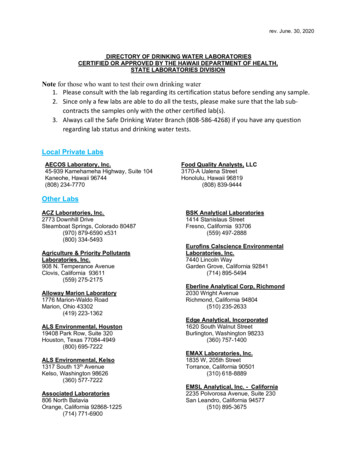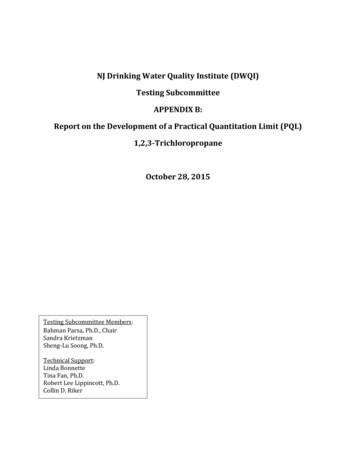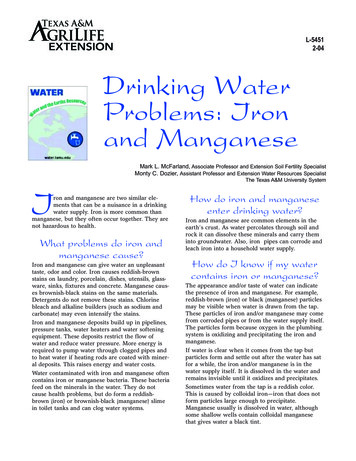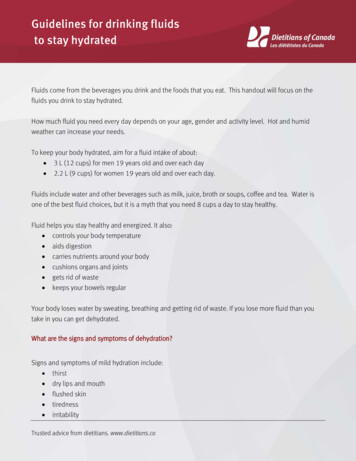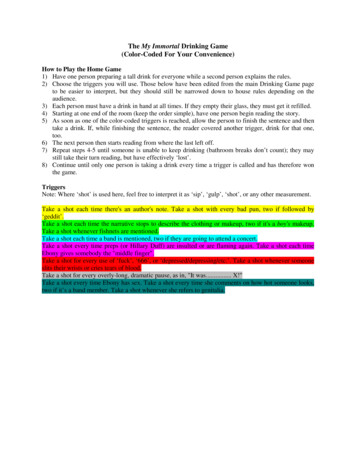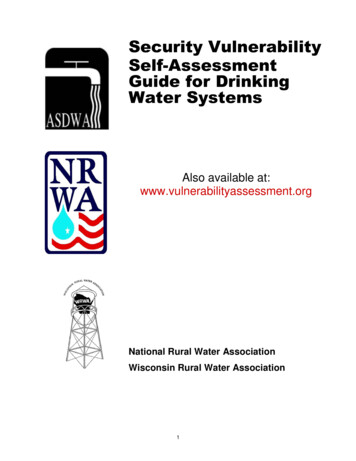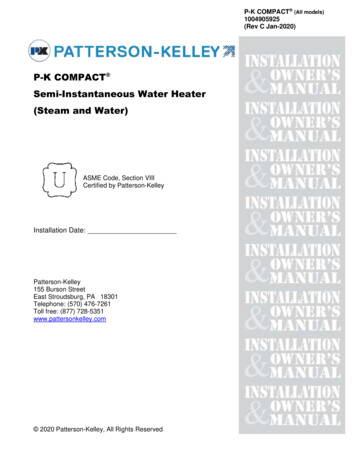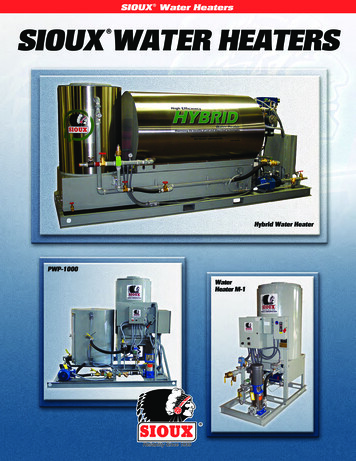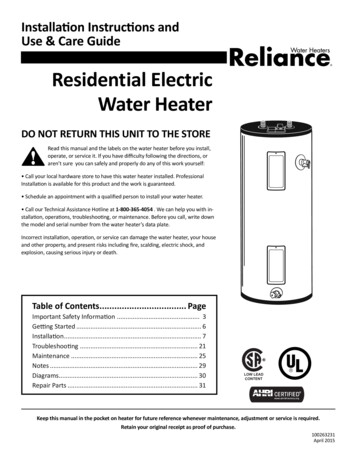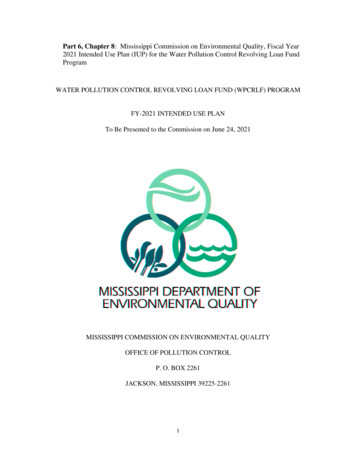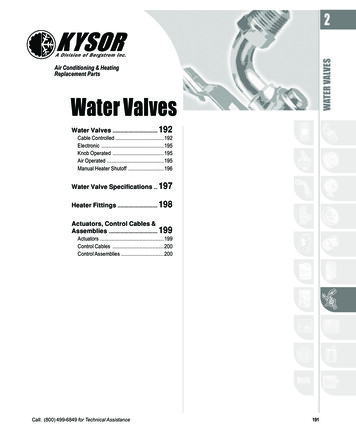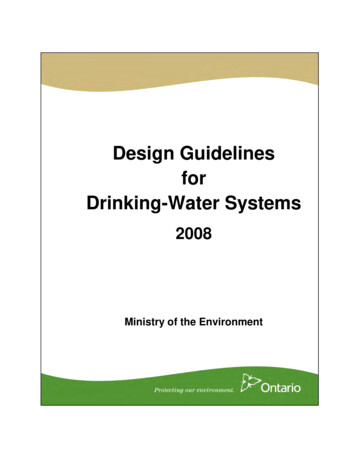
Transcription
Design GuidelinesforDrinking-Water Systems2008Ministry of the Environment
ISBN 978-1-4249-8517-3Ministry of the EnvironmentDesign GuidelinesforDrinking-Water Systems2008PIBS 6881e
Design Guidelines for Drinking-Water SystemsAcknowledgementsACKNOWLEDGEMENTSThe Design Guidelines for Drinking-Water Systems were prepared under the guidance ofthe Ontario Ministry of the Environment (MOE) Drinking Water Technical WorkingGroup with the assistance of XCG Consultants Ltd. in association with Hydromantis Inc.This document underwent review by various branches of the Ontario Ministry of theEnvironment and the following stakeholders and reviewers.Ministry of the Environment Drinking Water Technical Working GroupGeorge Lai, M.Eng., P.Eng., Standards Development Branch, MOEJanusz Budziakowski, M.Sc., P.Eng., Safe Drinking Water Branch, MOETony Edmonds, Ph.D., Ontario Clean Water AgencyJudith Patrick, Standards Development Branch, MOEStakeholders and ReviewersWilliam B. Anderson, Ph.D., Academia (University of Waterloo)Steve Burns, P.Eng., Ontario Water Works AssociationKaru Chinniah, M.Sc., P.Eng., Alberta EnvironmentRobert Dumancic, M. A. Sc., P. Eng., Standards Development Branch, MOEAndrew Farr, P.Eng., Association of Municipalities of OntarioBill Hargrave, Ph.D., P.Eng., Consulting Engineers of OntarioRod Holme, P.Eng., Engineering AdvisorDanny Hui, P.Eng., Ministry of Municipal Affairs and HousingTerry Lang, C.E.T., Ontario Water Works Equipment AssociationTony Lotimer, M.Sc., P.Geo., Ontario Water Works AssociationEdmond Lui, P.Eng., Safe Drinking Water Branch, MOEGord Robb, C.E.T., Ontario General Contractors AssociationJoe Rybak, P.Eng., Ontario Clean Water AgencyPervez Sunderani, P.Eng., Alberta EnvironmentCarl Vreugde, B.A., Ontario Water Works Equipment AssociationAlex Vukosavljevic, B.A., Operators (City of Toronto)Robert Walton, P.Eng., Ontario Municipal Water AssociationRoland Welker, M.A.Sc., P.Eng., Municipal Engineers AssociationMatt Uza, B.A.Sc., Land and Water Policy Branch, MOE2008i
Design Guidelines for Drinking-Water SystemsHistorical NoteHISTORICAL NOTESince the establishment of the Ontario Water Resources Commission under the OntarioWater Resources Act (1956), the commission engineers used the Ten States Standards forWater Works as the reference design guidelines for sanitary engineering practice. Thesepublications were prepared, edited and published, approximately every five years, by theGreat Lakes Upper Mississippi River Board of State Public Health Engineers and GreatLakes Board of Public Health Engineers. The commission engineers had also developedand applied internal advisory water works design guidelines based primarily on the TenStates Standards and included design, construction and operational experience specific toOntario.This practice has continued after the establishment of the Ministry of the Environment in1973. The Province of Ontario joined the Great Lakes-Upper Mississippi River Board ofState and Provincial Public Health and Environmental Managers and the Ten StatesStandards Water Supply Committee in 1977.Over the years, engineering design criteria based on generally accepted good engineeringpractice in Ontario have been developed and the following ministry guidelines werepublished:Guidelines for the Design of Water Treatment Works (1982)Guidelines for Water Distribution Systems (1979, 1985)Guidelines for Water Storage Facilities (1979, 1985)Guidelines for Servicing in Areas Subject to Adverse Conditions (1985)Guidelines for Water Supply for Small Residential Developments (1985)Guidelines for Seasonally Operated Water Supply Systems (1985)These guidelines have been revised and updated based on Ontario-specific engineeringpractice, the latest Ten States Standards (Recommended Standards for Water Works,2003) and other relevant North American design guidelines and published as the DesignGuidelines for Drinking-Water Systems (2008).2008ii
Design Guidelines for Drinking-Water SystemsPreamblePREAMBLEThe Ontario Ministry of the Environment (ministry) Design Guidelines for DrinkingWater Systems is intended for an audience that includes engineers who are responsible fordesigning drinking-water systems, ministry engineers responsible for reviewing andapproving the designs of such systems, and the municipalities/owners of the drinkingwater systems.It is intended that this Design Guidelines document be used with professional judgmentand experience in the design of drinking-water systems and in the engineering review ofapplications for approval of such systems. The ministry recognizes that the choice ofdrinking-water system designs may be influenced during the planning stages bysustainability issues, such as the cost to design and build drinking-water systems as wellas the ongoing cost to operate, maintain, rehabilitate and replace infrastructure.Designers should note that the ministry has a number of specific guidelines and/orprocedures which relate to drinking-water systems that may affect design. Such specificguidelines and procedures take precedence over these Design Guidelines.Similarly, the use of actual site-specific data is encouraged. Wherever possible, designersare encouraged to use actual data derived from the drinking-water system monitoringrecords and operational studies. Actual data can be compared to the typical valuesprovided in these Design Guidelines for comparison and consideration.As well, it should be noted that this Design Guidelines document provides designguidance related to established technologies. The fact that other technologies orequipment are not mentioned in the Design Guidelines should not be construed asprecluding their use. It is not the intention of the ministry to stifle innovation. Theministry will approve drinking-water system works designs if the applicant and designercan demonstrate that the works will have a reasonable and substantial chance of successfor the particular application. However, drinking-water system works designs using newand innovative technologies and equipment would be approved only where operationalreliability and effectiveness of the works has been demonstrated with a suitably-sizedprototype unit operating at its design load in the conditions suitable for the particularapplication.Finally, it must be emphasized that this document contains design guidelines. Legislation,including legislated standards and regulations, takes precedence over the DesignGuidelines and must be followed. Readers are cautioned to obtain their own legal adviceand guidance in this respect.2008iii
Design Guidelines for Drinking-Water SystemsTable of ContentsTABLE OF CONTENTSACKNOWLEDGEMENTS . iHISTORICAL NOTE . iiPREAMBLE . iiiLIST OF TABLES. viiiCHAPTER 1: LEGISLATIVE FRAMEWORK . 1-11.11.21.31.41.51.6GENERAL . 1-1APPLICABLE LEGISLATION ADMINISTERED BY THE MINISTRY . 1-1DRINKING WATER REGULATIONS & SUPPORT DOCUMENTS . 1-2OTHER APPLICABLE LEGISLATION . 1-2MINISTRY APPROVAL PROGRAM FOR DRINKING-WATER SYSTEMS . 1-3LEGAL CONSIDERATIONS . 1-4CHAPTER 2: PROJECT DESIGN DOCUMENTATION . 2-12.12.22.32.4GENERAL . 2-1STAGE 1 DOCUMENTS . 2-2STAGE 2 DOCUMENTS . 2-3STAGE 3 DOCUMENTS . 2-7CHAPTER 3: GENERAL DESIGN CONSIDERATIONS . 08GENERAL . 3-1PRE-DESIGN STUDY . 3-2TECHNOLOGY DEVELOPMENT . 3-3DESIGN FLOW . 3-5WATER CONSERVATION . 3-10PLANT CAPACITY RATING . 3-11SITE SELECTION CRITERIA . 3-14PLANT/ BUILDING LAYOUT. 3-15HYDRAULICS . 3-16ELECTRICAL COMPONENTS . 3-16INSTRUMENTATION & CONTROL . 3-16STANDBY POWER . 3-17EMISSIONS OF CONTAMINANTS TO AIR . 3-19PERSONNEL FACILITIES . 3-19BUILDING SERVICES . 3-20SAMPLING & MONITORING EQUIPMENT. 3-20LABORATORY FACILITIES . 3-21FLOW METERING . 3-23FACILITY DRINKING WATER SUPPLY . 3-24IN-PLANT PIPING . 3-24DISINFECTION AFTER CONSTRUCTION OR REPAIRS . 3-31MANUALS & TRAINING . 3-31SAFETY . 3-32SECURITY . 3-33FLOOD PROTECTION . 3-33CHEMICALS & OTHER WATER CONTACTING MATERIALS . 3-33iv
Design Guidelines for Drinking-Water Systems3.273.283.293.303.313.31Table of ContentsWATER TREATMENT PLANT RESIDUALS & SANITARY WASTE . 3-34ENERGY CONSERVATION . 3-34RELIABILITY & REDUNDANCY . 3-35OPERABILITY . 3-36CONSTRUCTABILITY . 3-37CLIMATIC FACTORS . 3-37CHAPTER 4: SOURCE DEVELOPMENT . 4-14.14.24.34.44.5GENERAL . 4-1SURFACE WATER . 4-2GROUNDWATER . 4-7GROUNDWATER UNDER THE DIRECT INFLUENCE OF SURFACE WATER . 4-8WELLS . 4-10CHAPTER 5: TREATMENT . 5.155.165.175.18GENERAL . 5-1PRE-ENGINEERED WATER TREATMENT COMPONENTS .
Since the establishment of the Ontario Water Resources Commission under the Ontario Water Resources Act (1956), the commission engineers used the Ten States Standards for Water Works as the reference design guidelines for sanitary engineering practice. These publications were prepared, edited and published, approximately every five years, by the
